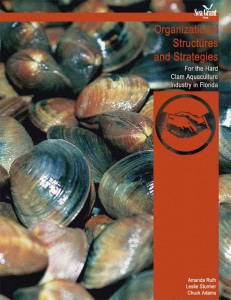Purpose:
The commercial hard clam culture industry in Florida is an unqualified success story. In 2003, there were more than 400 shellfish growers, who farmed submerged leases totaling over 1,700 acres, and over 140 million clams produced. This production had a farm-gate value in excess of $15 million, which represented a 34-fold increase in farmgate sales over 14 years. In addition, there were 14 hatcheries and 90 land-based nurseries and other businesses that provided input to the growout sector of the industry. As a result, the industry represents an important source of economic activity, jobs, and tax revenue to several coastal communities in Florida. To continue this growth, the industry may have a need for better organization on a statewide basis. Such statewide organization can be beneficial in regards to regional and national marketing and promotion, research and education on industry-wide problems, and more comprehensive political visibility and lobbying efforts.
Approach:
This study provided guidance on statewide organization for the commercial hard clam culture industry in Florida by characterizing the structure of and identifying strategies for successful agricultural and aquacultural organizations designed to provide the resources needed to solve current and projected industry problems. Objectives were to 1) characterize the structure of successful and relevant organizations, 2) identify successful revenue generating strategies, 3) provide the hard clam culture industry with options to help facilitate their organizational decisions, and 4) assist clam growers in Florida in developing an umbrella organizational strategy that may meet their future industry needs.
Results:
A mail survey of 23 questions was sent to directors and presidents of 85 agricultural and aquacultural organizations in Florida and across the US. The Dillman tailored design method was used. Follow-up phone interviews were conducted to gather more detailed information from selected survey respondents. The response rate was 35%. Of the respondents, 89% were nonprofit trade, 7% were a cooperative, and 4% were a state agency. Most respondents used a voluntary method of generating revenue. Approximately half used a fixed dues rate, while 39% used a production assessment. About 11% used a mandatory program, with 7 and 3.5% using a checkoff and marketing order, respectively. With regard to internal organizational structure, the majority (67%) used an elected board of directors, 10% used an appointed board, and 10% used elected/appointed boards. The average board size was 14 members, with the size ranging from 5 to 38 members. Eighty percent (80%) of the respondents used paid administrative staff. Most respondents used open membership, 57% having membership from other states and other commodities. Membership sizes ranged from 17 to 9,000 members, with membership rosters representing from 10 to 93% of the industry volume/value. The study also identified numerous other successful organizational strategies for services offered, recruitment techniques, considerations for initial organization, success measurement, organizational roadblocks, and recommendations.

A number of presentations about project results have been made at state, regional, and national meetings. The presentation and report below can be viewed in
PDF format.
Investigators and Partners:
- Leslie Sturmer, University of Florida IFAS Shellfish Aquaculture Extension
- Amanda Ruth, University of Florida IFAS Agricultural Education and Communications Department
- Chuck Adams, University of Florida IFAS Food and Resource Economics Department
- Numerous agricultural and aquacultural organizations across the U.S.
Funding:
- USDA Risk Management Agency
- Florida Sea Grant College Program
 A number of presentations about project results have been made at state, regional, and national meetings. The presentation and report below can be viewed in PDF format.
A number of presentations about project results have been made at state, regional, and national meetings. The presentation and report below can be viewed in PDF format.

